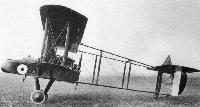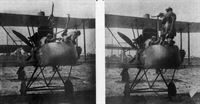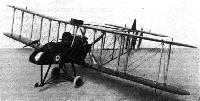
Описание
Страна : Великобритания
Год : 1914
Двухместный истребитель
Варианты
- RAF - F.E.2 - 1914 - Великобритания
- Vickers - VIM - 1920 - Великобритания
Royal Aircraft Factory F.E.2
Самолет F.E.2 был создан ранее модели B.E.12 и представлял собой попытку решения проблемы повышения огневой мощи в передней полусфере - еще до того, как был изобретен синхронизатор. Самолет представлял собой биплан, имевший двухместную гондолу-фюзеляж, а двигатель располагался в хвостовой части последней и вращал толкающий воздушный винт. Пилот находился в задней кабине, а в передней сидел наблюдатель-стрелок, имевший сектор обстрела более 180°.
Первой модификацией стал F.E.2a, оснащенный двигателем Green мощностью 100 л. с., но его плохие летные характеристики привели к тому, что на F.E.2b, поступавший во Францию с небольшом количестве до конца 1915 года, был уже установлен более мощный двигатель Beardmore мощностью 120 л. с.
Компания также выпустила два самолета F.E.2c, отличавшихся тем, что пилот находился впереди, а наблюдатель - сзади. Данная машина предназначалась для полетов ночью. Обозначение F.E.2d получил вариант, имевший схожий планер, но оснащавшийся двигателем Rolls-Royce мощностью 250 л.с, позже получившим название Eagle и обеспечивавшим значительно лучшие характеристики, особенно скороподъемность и практический потолок.
Обозначения F.E.2e, F.E.2f, F.E.2g и F.E.2h были даны нескольким экспериментальным самолетам, оснащавшимся различными двигателями. На фронте F.E.2b действовали вместе с Airco DH.2, что позволило снизить потери от немецких монопланов Fokker, однако они не могли на равных противостоять новым немецким самолетам Albatros и Halberstadt, появившимся в конце 1916 года.
С другой стороны, приспособленность F.E.2b для ночных полетов побудила командование использовать их для ночных бомбардировок в Европе, а также - в небольших количествах - для обороны от дирижаблей Zeppelin и бомбардировщиков Gotha. Всего было построено 1939 самолетов F.E.2a/ F.E.2b.
ТАКТИКО-ТЕХНИЧЕСКИЕ ХАРАКТЕРИСТИКИ
Royal Aircraft Factory F.E.2b
Тип: двухместный истребитель
Силовая установка: один рядный ПД Beardmore мощностью 120 л. с. (89 кВт)
Летные характеристики: максимальная скорость на уровне моря 129 км/ч; практический потолок 2745 м; продолжительность полета 3 ч
Масса: пустого 904 кг; максимальная взлетная 1347 кг
Размеры: размах крыльев 14,55 м; длина 9,83 м; высота 3,85 м; площадь крыльев 45,89 м2
Вооружение: первоначально - один 7,7-мм пулемет Lewis, затем был добавлен второй пулемет Lewis; в бомбардировочном варианте - максимум 159 кг бомб в различной комбинации
- Описание
Фотографии
-
Мировая Авиация 225
Регистрационный номер: A5461 A5461 - самолет модификации F.E.2b, на нем летал капитан Клемент из 22-й эскадрильи Королевского летного корпуса. Подразделение было сформировано в 1915 году для ведения разведки.
-
Aeroplane Monthly 1986-05 / B.Robertson - A present from... (1)
Royal Aircraft Factory F.E.2b Baroda.
-
Aeroplane Monthly 1983-10 / L.Coombs - Cockpits of the RAF (1)
Регистрационный номер: 5647 F.E.2 успешно действовали как легкие ночные бомбардировщики и как ночные истребители ПВО метрополии, действуя против немецких дирижаблей Zeppelin. Данный F.E.2b в черной окраске принадлежал 100-й эскадрилье Королевского летного корпуса.
"FACTORY DESIGNED": THE F.E.2B, 120 BEARDMORE ENGINE, WAS USED BY NO.20 SQUADRON AND OTHERS, AND HELPED TO DEFEAT THE FOKKER MONOPLANE. IT WAS A PUSHER, WITH OPEN TAIL GIRDER.
This F.E.2a, 5647 Bombay No. 2, was fitted with an F.E.2b-type nacelle and shows the vertically staggered cockpits, which gave both pilot and observer a good forward field of vision. 5647 served with No. 16 Squadron. -
Мировая Авиация 225
F.E.2 успешно действовали как легкие ночные бомбардировщики и как ночные истребители ПВО метрополии, действуя против немецких дирижаблей Zeppelin. Данный F.E.2b в черной окраске принадлежал 100-й эскадрилье Королевского летного корпуса.
-
Jane's All the World Aircraft 1980 / Encyclopedia of Aviation - Aircraft A-Z - v5
Регистрационный номер: 5660 Royal Aircraft Factory F.E.2b.
-
Мировая Авиация 225
Регистрационный номер: A852 Во время операции на реке Сомме самолеты F.E.2b обеспечивали так необходимую авиационную поддержку.
-
Aeroplane Monthly 1978-11 / Personal album
Регистрационный номер: A5794 Royal Aircraft Factory F.E.2b A5794 is a Scottish-built example of this doughty reconnaissance fighter cum night bomber. By August 1917 the F.E.2b was serving only in the night bombing, anti-submarine and Home Defence roles, and it ended its service life in training units, where it was used to teach observers. This example was with No 1 School of Navigation and Bomb-dropping at Stonehenge in May 1918.
-
Air Pictorial 1956-01 / J.Bruce - The FE.2b /Aeroplanes of 1914-18 War/
Регистрационный номер: A5548 A Weir-built F.E.2b (A5548). Unusual are the red white and blue stripes round the nacelle 's nose.
-
Aeroplane Monthly 1985-04 / Personal album
Регистрационный номер: D9163 One of the types flown by Mr Jones was the F.E.2b; the example, D9163, bore night markings and was used for bomb-aiming training.
-
Aeroplane Monthly 1978-07 / Personal album
Регистрационный номер: A6516 [7] The overwing gravity petrol tank can be seen, as well as the radiator immediately behind the pilot. The F.E.2d cost about £2,970, had an operational ceiling of 17,500ft, an endurance of 3 1/4 hr, and a speed of 90 m.p.h. at 10,000ft. It could reach 180 m.p.h. in a “power dive”.
-
Aeroplane Monthly 1978-07 / Personal album
Регистрационный номер: A6516 [7] Capt “Inky” Stevens (left) and W. C. Cambray with A6516. In flight the two communicated by sign language, which was developed to a great art. Cambray described Stevens, an Irishman, as a "truly great pilot". Note the generous armament of three Lewis guns, one fixed to fire forward, one on a pivoted forward mounting, and another on a pillar behind the observer’s seat to enable the tail to be defended. The bomb sight can be seen at the side of the pilot’s cockpit.
-
Aeroplane Monthly 1982-10 / B.Gunston - The classic aero engines (2)
Регистрационный номер: A6516 [7] F.E.2ds were powered by various marks of Rolls-Royce Eagles. The cost of an Eagle engine was nearly as much as an F.E.2d airframe, about £1500.
-
Aeroplane Monthly 1978-07 / Personal album
Регистрационный номер: A6516 [7] Capt “Inky” Stevens and W. C. Cambray in their aeroplane, A6516 was a presentation aircraft, bearing the legend “Presented By The Colony of Mauritius No 13” on its nacelle. In the side view the faired pylon for the tailplane bracing is conspicuous
-
Aeroplane Monthly 1978-07 / Personal album
Регистрационный номер: A6516 [7] Preparing for take-off and waiting for two men to swing the propeller. The aerial camera on the port side is clearly visible. On their last flight, Stevens and Cambray had a dog fight with some “huns” but managed to return to their aerodrome, where the F.E. was found to be “completely unserviceable”. A6516 was built by Boulton & Paul Ltd. at Norwich.
-
Aeroplane Monthly 1978-07 / Personal album
Регистрационный номер: A6516 [7] Left: W. C. Cambray demonstrates the position adopted for taking aerial photographs. The cameras used 6in, 8in, and 15in focal lens with a yellow filter behind them. The top box housed 18 5in x 4in glass plate negatives, and a photo was taken by pressing the plunger. The exposed plate was then moved to bottom box by moving a lever.
Right: The perilous position adopted when using the pillar-mounted gun to defend the tail, while the pilot did his best to outmanoeuvre the enemy. One in three of the 1,000 rounds of ammunition was a tracer bullet. It was common practice for F.E.2ds to fly in circles when attacked in order to provide mutual protection. Without any oxygen, the feat of moving from one gun to another at altitude demanded a great deal of effort from the observer. -
Aeroplane Monthly 1985-06 / P.Lamboit - Eyes in the sky (1)
Capt F. C. V. Laws in the front seat of an F.E.2b in 1916, en route from Farnborough to France on special duties.
-
Aeroplane Monthly 1978-07 / Personal album
Регистрационный номер: A6516 [7] A study of A6516 in flight, displaying the distinctive twin-boom layout of the F.E.2d, with the observer perched out in the front where he had a clear field of fire forwards. The 250 h.p. Rolls-Royce engine drove a large, four-bladed propeller, and the boss and one blade from A6516 is now displayed in the RAF Museum. On bombing raids eight 25lb Cooper bombs were carried on the underwing racks visible in this picture. The target had to be overflown twice - once to set the bomb sight and again to release the bombs. Both day and nighttime patrols were flown.
-
Air Enthusiast 1996-11 / Round-Out
Регистрационный номер: G-EAHC Bearing the race number ‘4’, FE.2b G-EAHC as flown by U Carter Smith in one of the Moordown air races. G-EAHC was the only FE.2b to go onto the UK civil register. Built as D3832 by Garrett and Sons of Leiston, it was registered in July 1919 to Carter Smith but transferred to the Bournemouth Aviation Company in March 1920. It was withdrawn from use by August 1921.
-
Air Enthusiast 1994-09 / J.Grant - When the Paperwork Triumphed!
Регистрационный номер: G-AUCX FE2b G-AUCX at Kalgoorlie, Western Australia, January 1922.
-
Flight 1920-04 / Flight
The line-up for the cross-country race at Bournemouth on Easter Monday. From left to right the machines are Caudron G.3 (70 h.p. Renault), F.E.2b (160 h.p. Beardmore), De H.6 (80 h.p. Renault), Avro (110 h.p. Le Rhone), Avro (110 h.p. Le Rhone), Avro (110 h.p. Le Rhone). The course was a double-circuit from the Bournemouth Aerodrome, round Christchurch Priory, a distance of 20 miles.
Другие самолёты на фотографии: Avro Avro 504 - Великобритания - 1913Caudron G.3 - Франция - 1913De Havilland D.H.6 - Великобритания - 1917
-
АвиаМастер 2007-02 / Д.Евстафьев - Наши жены - пушки заряжены! /Арсенал/
"Рокет ган" на самолете FE.2D.
-
Aviation Historian 5 / P.Jarrett - Pioneering the Fighter (2)
The second and third S.E.4as, 5610 and 5611, under construction in the F.1 Shop at Farnborough on July 15, 1915, with the forward fuselage of the fourth and final S.E.4a, 5612, in the left foreground. A couple of nacelles for F.E.2a pushers are also under construction in this fascinating photograph.
Другие самолёты на фотографии: RAF S.E.4 - Великобритания - 1914
-
Flight 1935-05 / Flight
AN INTERESTING CONTRAST to models of modern aeroplanes is this scale-model F.E.2D, made for the Science Museum, London. Museum models of this kind are usually made from wood with brass or aluminium details, and at least three coats of paint (usually cellulose) are very carefully applied, with a rubbing-down between each. The makers of this and a number of other models in the Museum are the Models Manufacturing Company, 43, Newington Causeway, London, S.E.1.
-
Air-Britain Aeromilitaria 1981-04
As a service to readers who are having difficulty in doing engine changes on their executive FE.2Bs, we show the method on the back cover. Having idly wondered how this was done amidst all those struts and wires for many years, it was interesting to come across an illustration of the purpose-built engine stand to be used.
- Фотографии

























